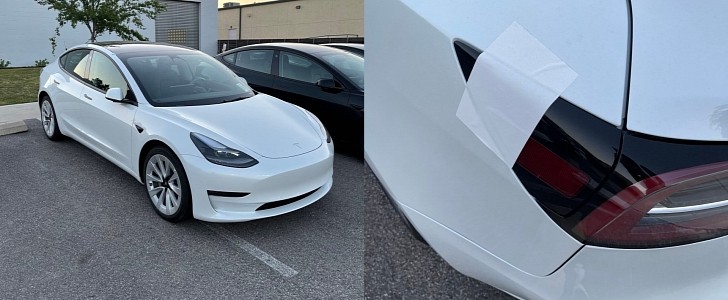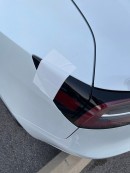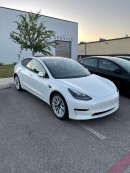No carmakers have been safe from the microchip shortage, with the notable exception of Tesla, which consistently increased production while others got used to cuts. Recent reports show that the situation has worsened enough that even Tesla started building cars with missing chips.
Modern automobiles are more like computers on wheels than anything else, so the microchip shortage has gotten the best of the auto industry. Factories repeatedly stopped production or opted to build vehicles without electronic components. At the same time, overflow parking full of unfinished cars became a regular sighting around manufacturing plants.
There was only one carmaker that did seem unaffected by the microchip supply problems: Tesla. The EV maker continued to build cars at an ever-increasing pace even through the worst of the chip crisis. It managed to do so because Tesla is a highly vertically integrated car manufacturer, meaning it produces in-house most of its parts.
This level of integration allows the EV maker to easily use whatever electronic components it can grab from the market and repurpose them, quickly changing the design as it sees fit. The software is also quickly reprogrammed to make use of the different chips. Another Tesla advantage is that it designs many specialized chips inside its vehicles. This allowed it to maintain a closer relationship with chip factories than other carmakers that source their chips via various suppliers.
This is mainly why Tesla was largely unaffected by the microchip problems up until now. According to recent reports on TMC forums cited by driveteslacanada.ca, even Tesla started to build cars with missing components. A constraint on the charge port ECU has left hundreds of Tesla customers waiting for their vehicles. Just like in the case of Ford and other carmakers, the partially finished cars were stored in parking lots at delivery centers across the U.S.
Some of the affected Tesla customers said they were assigned a VIN and were supposed to take delivery of their cars within days before being pushed back without explanation. Several were even able to visit the delivery center and found their assigned Tesla sitting in the parking lot with a piece of white tape covering the charge port.
Pressed by the frustrated customers, delivery advisors admitted the cars were built and shipped without the charge port ECU. Deliveries were put on hold until the parts arrived. This is unpleasant at best, with several people indicating they already paid the car in full or are repaying on loan for a vehicle they don’t have. Pressed with questions, some delivery advisors said the missing parts should arrive in a couple of weeks, while others said there is no timeframe for the delivery.
This presents a new problem, as some people have their cars waiting in the parking lot for more than two months. During this time, charging is impossible due to the missing chip that controls the charging port. In that case, the battery will most likely fully discharge by the time the car is ready to ship, potentially affecting its lifecycle.
A TMC user even said that he wanted his battery to fail because of this blunder so that Tesla would pay for the replacement. Considering that a replacement would probably take months, we’re not sure this is the best outcome.
There was only one carmaker that did seem unaffected by the microchip supply problems: Tesla. The EV maker continued to build cars at an ever-increasing pace even through the worst of the chip crisis. It managed to do so because Tesla is a highly vertically integrated car manufacturer, meaning it produces in-house most of its parts.
This level of integration allows the EV maker to easily use whatever electronic components it can grab from the market and repurpose them, quickly changing the design as it sees fit. The software is also quickly reprogrammed to make use of the different chips. Another Tesla advantage is that it designs many specialized chips inside its vehicles. This allowed it to maintain a closer relationship with chip factories than other carmakers that source their chips via various suppliers.
This is mainly why Tesla was largely unaffected by the microchip problems up until now. According to recent reports on TMC forums cited by driveteslacanada.ca, even Tesla started to build cars with missing components. A constraint on the charge port ECU has left hundreds of Tesla customers waiting for their vehicles. Just like in the case of Ford and other carmakers, the partially finished cars were stored in parking lots at delivery centers across the U.S.
Some of the affected Tesla customers said they were assigned a VIN and were supposed to take delivery of their cars within days before being pushed back without explanation. Several were even able to visit the delivery center and found their assigned Tesla sitting in the parking lot with a piece of white tape covering the charge port.
Pressed by the frustrated customers, delivery advisors admitted the cars were built and shipped without the charge port ECU. Deliveries were put on hold until the parts arrived. This is unpleasant at best, with several people indicating they already paid the car in full or are repaying on loan for a vehicle they don’t have. Pressed with questions, some delivery advisors said the missing parts should arrive in a couple of weeks, while others said there is no timeframe for the delivery.
This presents a new problem, as some people have their cars waiting in the parking lot for more than two months. During this time, charging is impossible due to the missing chip that controls the charging port. In that case, the battery will most likely fully discharge by the time the car is ready to ship, potentially affecting its lifecycle.
A TMC user even said that he wanted his battery to fail because of this blunder so that Tesla would pay for the replacement. Considering that a replacement would probably take months, we’re not sure this is the best outcome.






